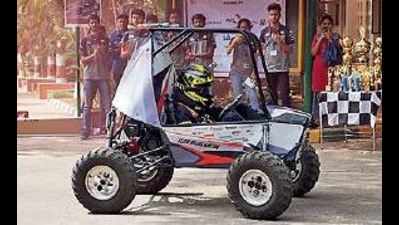- News
- City News
- bengaluru News
- ATV built by Bengaluru students has sensors to monitor every move
Trending
This story is from January 14, 2020
ATV built by Bengaluru students has sensors to monitor every move
Here is a gearless all-terrain vehicle, built by students of RV College of Engineering, that constantly collects data from different sensors in its parts as it manoeuvres pits, rocky roads and even forests. The data helps students improve the vehicle with every ride.

The vehicle, GT-20 (Go, THR), built by students of RV College of Engineering, is named after Team Helios Racing
BENGALURU: Here is a gearless all-terrain vehicle, built by students of RV College of Engineering, that constantly collects data from different sensors in its parts as it manoeuvres pits, rocky roads and even forests. The data helps students improve the vehicle with every ride.
The vehicle, GT-20 (Go, THR), is named after the RVCE club — THR (Team Helios Racing) — which started in 2005.GT-20 was unveiled on Monday by a team of 50-odd members, faculty and other students. It is all set to compete at national and international competitions in the next four months.
At the international level, THR’s vehicle had emerged the second fastest at Baja SAE, an off-road vehicle competition for engineering students held at Rochester in 2016, while in 2019, it was the seventh fastest.
Chinmay Bukinkere, the captain of THR and fourth-year mechanical engineering student, said GT-20 has evolved to a great extent since the club’s vehicle in 2007, all thanks to its sensor system.
“These continuous updates helped us develop vehicles down the years as well as each prototype during its testing period,” Bukinkere said. “The top speed has gone up from 40-45 km/hour in 2007 to 65 km/hour now. Even the weight of the vehicle has been brought down by almost 300kg to around 135kg,” Bukinkere said.
Nataraj JR, THR’s faculty adviser told TOI that the students got help from sponsors to build their vehicles in a budget of Rs 18-20 lakh.
“Students have put in extra hours and worked on prototypes relentlessly to come up with the perfect vehicle,” he said.
As the team gets ready to participate in two nationallevel competitions and the Baja SAE, Arizona in April, Bukinkere hopes to be one amongst the top three.
The vehicle, GT-20 (Go, THR), is named after the RVCE club — THR (Team Helios Racing) — which started in 2005.GT-20 was unveiled on Monday by a team of 50-odd members, faculty and other students. It is all set to compete at national and international competitions in the next four months.
At the international level, THR’s vehicle had emerged the second fastest at Baja SAE, an off-road vehicle competition for engineering students held at Rochester in 2016, while in 2019, it was the seventh fastest.
Chinmay Bukinkere, the captain of THR and fourth-year mechanical engineering student, said GT-20 has evolved to a great extent since the club’s vehicle in 2007, all thanks to its sensor system.
“We have sensors attached to each part which transmit updates to respective teams in the control room, thus helping them understand the functioning on a real-time basis,” Bukinkere said, explaining how a sensor on the transmission system gives updates on its heating and helps them understand the amount of pressure it can tolerate. Over 12 such specialised teams monitor different parts of the vehicle.
“These continuous updates helped us develop vehicles down the years as well as each prototype during its testing period,” Bukinkere said. “The top speed has gone up from 40-45 km/hour in 2007 to 65 km/hour now. Even the weight of the vehicle has been brought down by almost 300kg to around 135kg,” Bukinkere said.
Nataraj JR, THR’s faculty adviser told TOI that the students got help from sponsors to build their vehicles in a budget of Rs 18-20 lakh.
“Students have put in extra hours and worked on prototypes relentlessly to come up with the perfect vehicle,” he said.
As the team gets ready to participate in two nationallevel competitions and the Baja SAE, Arizona in April, Bukinkere hopes to be one amongst the top three.
End of Article
FOLLOW US ON SOCIAL MEDIA










